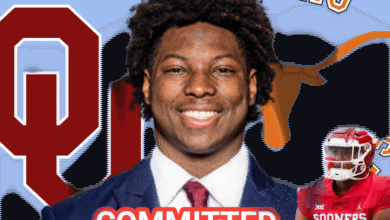🚨 NCAA Considers Major Shift in Transfer Policy: Growing Momentum Behind Single Football Transfer Portal Window Sparks Debate Across College Athletics, With January or April Window Emerging as Final Contenders…
🚨 NCAA Considers Major Shift in Transfer Policy: Growing Momentum Behind Single Football Transfer Portal Window Sparks Debate Across College Athletics, With January or April Window Emerging as Final Contenders...
The NCAA is on the brink of a historic change that could reshape the landscape of college football transfers for years to come. According to multiple high-level sources across Power Five conferences, there is growing momentum behind the push to streamline the current dual-window system into a single, unified transfer portal window, with January and April emerging as the two leading candidates for the new time frame.
What began as a quiet policy conversation within the NCAA’s Division I Council has rapidly transformed into a nationwide debate involving athletic directors, coaches, compliance officers, and student-athletes. The outcome—potentially just days away—could drastically change how programs manage their rosters, how student-athletes plan their futures, and how competitive balance is maintained across college football.
📌 The Current System: Two-Windows, Confusion, and Chaos
At present, the NCAA operates under a two-window transfer portal system for football:
- A 45-day window in the winter (typically opening in early December after championship selections)
- A 15-day window in the spring (typically in late April through early May)
These windows were originally intended to give players clarity and flexibility while helping programs maintain roster stability. But in practice, the system has drawn criticism for being too fragmented, creating chaotic roster churn, and complicating scholarship management.
A Power Five athletic director, who spoke on condition of anonymity, said:
“There’s no rhythm to roster construction anymore. It feels like free agency, twice a year, with no real off-season for anyone.”
⚖️ Why a Single Transfer Portal Window?
The new proposal gaining steam is to reduce the two windows into one consolidated period, either in January (after bowl games and playoff participation) or in April (after spring football). Advocates of the change argue that this approach would benefit both players and programs, creating a more orderly, transparent, and athlete-friendly process.
🔹 Pros of a Single Window:
- Roster clarity before summer workouts and fall camp
- Simplified scholarship planning for coaches
- Less mental stress and uncertainty for players
- Improved academic continuity for athletes switching schools
- Reduces tampering and speculation across two separate periods
Notre Dame Head Coach Marcus Freeman recently shared:
“It’s tough enough managing your roster once, but doing it twice with less than two months between spring ball and summer camp is just too much. We need a clear, singular process that’s fair to everyone.”
🗓️ January vs. April: The Timing Battle
The most heated part of the conversation is not whether to have one window—but when it should happen.
✅ January Option (Postseason)
- Players finish the season and enter portal in January after bowl games or playoffs
- Offers time for programs to replace outgoing players ahead of spring practices
- Gives early enrollees and spring practice transfers time to settle academically
However, this option has drawn concerns about:
- Short turnaround after intense post-season
- Overlap with NFL Draft decisions
- Coaching turnover impacting portal decisions
✅ April Option (Post-Spring)
- Players complete spring ball and enter portal in late April
- More time for coaching staffs to evaluate rosters
- Reflects a more realistic understanding of depth charts after spring
Yet, the April window creates problems too:
- Summer enrollment crunch for transfers trying to join new programs
- Less time to onboard athletes ahead of fall camp
- Could encourage players to transfer simply due to spring depth chart anxieties
🔍 Feedback from Coaches & Players
Many football coaches across FBS have expressed cautious optimism about the single-window plan. Oklahoma Sooners Head Coach Brent Venables offered a thoughtful perspective:
“I support simplifying things, especially for our players. But the key is timing. We’ve got to pick a window that supports both competitive integrity and the student-athlete experience.”
Meanwhile, athletes have mixed reactions. Some prefer January, especially those looking for early decisions on their future. Others lean toward April for the flexibility to re-evaluate after spring.
University of Michigan quarterback Jaden Davis said:
“You can’t make an informed transfer decision without seeing spring ball through. I’d want April.”
🏛️ Inside the NCAA: Decision Imminent
The NCAA Division I Council is expected to vote as early as next week, possibly concluding the matter before the start of summer conference media days. Sources suggest that while not unanimous, the majority of administrators favor a single-window system, and the debate now hinges solely on the date.
Working groups within the NCAA have already circulated legal and logistical documentation for both proposals, including recommendations from university compliance officers, academic coordinators, and mental health specialists.
A source close to the NCAA compliance subcommittee noted:
“There’s alignment from all corners that the current two-window system isn’t working well. What remains is choosing the lesser of two evils, and doing so with data, not pressure.”
📈 Impact on Recruiting, NIL, and Roster Management
Beyond just calendar shifts, the implementation of a single transfer window has ripple effects across:
- Recruiting timelines: Coaches will push harder for clarity in late fall or late spring, depending on the chosen window.
- NIL negotiations: With fewer windows, NIL collectives will need to act faster and more decisively.
- Scholarship budgeting: A unified window simplifies scholarship management but adds urgency to decisions.
Lincoln Riley of USC warned:
“A one-window system increases the stakes—both for us as coaches and for kids. The pressure is going to be intense, no doubt.”
📉 Who Stands to Lose?
While the move may benefit stability, not everyone is happy.
Smaller programs and Group of Five schools worry that a single window could create a “power raid” effect, where top schools target spring standouts en masse in one fell swoop, giving little time for smaller programs to respond.
A MAC head coach put it bluntly:
“One window just means we lose our best players once instead of twice. It still hurts. But now, we get no second chance to reload.”
Some academic advisors are also concerned about players transferring quickly with less time to process academic implications, particularly in compressed windows like April.
🌐 The Bigger Picture: What This Means for College Football
At its core, the move to a single transfer portal window reflects a broader philosophical shift in how college football operates. It’s a tug-of-war between modern flexibility and traditional structure, between athlete freedom and institutional stability.
This isn’t just a logistical change—it’s a fundamental rethinking of how the sport adapts in an era dominated by NIL, national TV deals, and expanding playoffs.
And with realignment, superconferences, and revenue-sharing models already transforming the college landscape, the NCAA knows that every decision it makes must strike the right tone.
🔮 What Comes Next?
Once the Division I Council votes—potentially within the next 7–10 days—the outcome will set the new policy for the 2025–26 cycle. Barring unexpected resistance, it’s widely expected that:
- The two-window system will be eliminated
- A single window will be selected (with current betting odds favoring January)
- Formal implementation guidelines will follow in July
Athletic departments across the country are already preparing. Compliance officers are drafting new education plans for players, and head coaches are adjusting summer recruiting boards.
The College Football Players Association (CFBPA) also issued a short statement encouraging clarity and early communication:
“We support reforms that reduce chaos and protect athletes’ futures. Transparency and support systems will be critical in any new model.”
📢 Final Thought: Is Simpler Always Better?
For years, the NCAA has been criticized for slow, reactive policy shifts. But the speed and seriousness of this transfer portal reform effort suggests a new direction—one that emphasizes efficiency, clarity, and competitive equity.
As one SEC administrator noted:
“We’ve heard the complaints, seen the data, and lived the headaches. If we can land on the right solution now, it’ll be one of the smartest things we’ve done in a decade.”
Time will tell whether the one-window policy becomes a cornerstone of a more modern, fair, and manageable college football ecosystem—or just another rushed reform with unintended consequences.
Either way, college football’s future is being written this week, and the writing is bold.
Stay tuned as the NCAA Division I Council prepares for a potential vote next week. We will provide real-time updates as this historic decision unfolds.
















